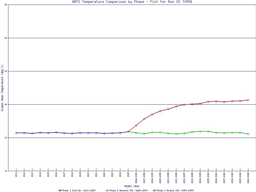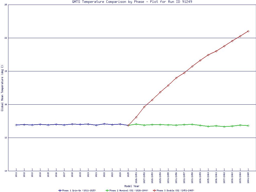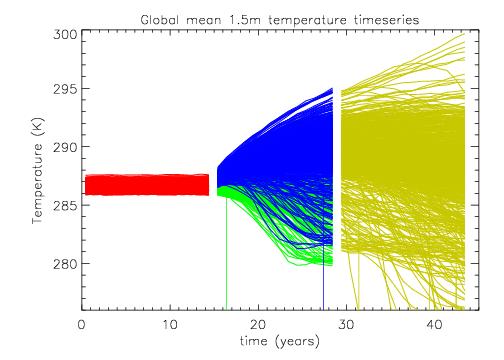
Coolwire 11 2 February 2005
Critique of Climateprediction.net claim (as published in their January 2005 Letter to Nature) that their modelling indicates 11 degrees C global temperature rise is plausible after carbon dioxide doubling.
I have been
intrigued at the media claims of "...up to 11 degrees..." temperature increase
from this http://www.climateprediction.net
Oxford Uni group which utilises tens of thousands of idle PC's worldwide
to run their climate model.
Apart from the fact that it is very difficult seeing exactly where
they get their 11 degrees from, I can only see a max increase of ~8 degrees
in Fig 1 of their Jan 05 Letter to Nature which is easily downloadable off
their website. As is their 26 January 2005 Press Release.
Their Fig 2
a, a histogram shows that only a tiny proportion of runs produce a
result ~11 degrees. The vast majority of models predict only a ~3.5
degree rise after the 15 year run post instant CO2 doubling.
It must be a worry for their future work out to 2100 that most of that
3.5 degree rise is in the first 5 years, then T shows little change out
to the 15 years.
Let's just
walk through some of their web pages.
Starting at the http://www.climateprediction.net
Home Page.
Follow their Climate Science link at left, look down for link to page
setting out their "Experiment strategy - the basics"; We see this
Table setting out their grand strategy. As far as I can find they are yet
to tell anything of Experiments 2 and 3.
Calibration results are seen on their Graphs as 1810 to 1825, the Pre-industrial CO2 run (sometimes termed Control) is from 1825 to 1844, the Double CO2 run is from 2051 to 2065. Note that for this run CO2 is doubled instantly to 550 ppm. Why not input annual incremrents as in the real world ?? Now scroll below the table for some early results.
Strategy Table from http://www.climateprediction.net/science/strategy.php
Explore model sensitivity to parameters Identify suitable ranges of parameters. Each simulation includes 3 phases: Simulation of 1950-2000 Assess model skill by making a probability based forecast
of the past climate. Run the model with a range of initial conditions and parameters for the period 1950-2000.
Compare model outputs with observations to assess how well the model
performs. Simulation of 2000-2100 Make a probability based forecast of future climate.
Run the model with a range of initial conditions, forcings and parameters for the period 2000-2100.
We look at some results from their first 5000 runs at http://www.climateprediction.net/science/firstresults.php
A stable, "normal" run. Most of the runs we are
getting back at the moment look fairly similar to this 74958 Click
on graph for large screen copy. The blue line is the 1810 to 1825 phase.
The green line 1825 to 1840 is the control phase. The red line
is the 2050 to 2065 doubled CO2 phase.

